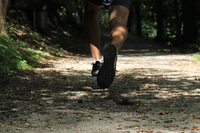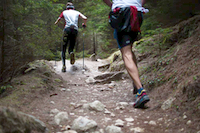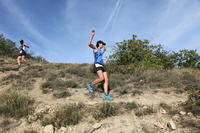The Joy of Running - Part Three - Different Trail Types

The cumulative effect of running on hard surfaces all of the time, can be brutal on your musculoskeletal system. Running on grass, or wood chip trails is an excellent way to reduce the impact of each foot strike. Giving your body a break from the hard surfaces, will also give you a pleasant change of scenery.
Everyone has their own idea of what trail running is. For some, it is not running on concrete or asphalt.  There are so many kinds of trails to run or walk on, so be aware of what kind of trail you are about to engage. Some trails are well groomed gravel or asphalt pathways. You'll also find grass or wood chip surfaces. Unimproved trails, will feature a natural selection of rocks and tree roots that crisscross over the pathway. Be aware, there are trails, that almost require mountaineering skills. with dangerously steep topography.
There are so many kinds of trails to run or walk on, so be aware of what kind of trail you are about to engage. Some trails are well groomed gravel or asphalt pathways. You'll also find grass or wood chip surfaces. Unimproved trails, will feature a natural selection of rocks and tree roots that crisscross over the pathway. Be aware, there are trails, that almost require mountaineering skills. with dangerously steep topography.
For safety precautions I recommend the following:
- Reliable guidance (GPS is excellent, or a good map)
- Mobile phone
- Eye protection (clear, amber, or sunglasses are good)
- Hand protection (light weight gloves)
- Hydration and nutrition
- Reliable running or hiking shoes
- Jacket or vest is a good idea if there is lot of elevational gain or loss.
Selecting the proper running shoes and accessories will help you to enjoy your trail run, and safety.  If you are running only on asphalt pathway trails, you'll feel comfortable in your regular road running shoes. When you get into grass, woodchip, gravel, or unimproved trails, you must select a running shoe that provides good traction.
If you are running only on asphalt pathway trails, you'll feel comfortable in your regular road running shoes. When you get into grass, woodchip, gravel, or unimproved trails, you must select a running shoe that provides good traction.
You'll need a shoe that climbs and descends well. That's because if you slip and fall going up a hill, you'll generally regain traction quickly, and continue the climb without injury. Descending on a trail can be dangerous. Especially when the trail is wet, with rocks and roots. A fall here could be catastrophic.
NOTE: You don't need to run every step of the trail. If conditions are precarious, it is best to walk on those sections of the trail.

Your trail running shoes should have a low center of gravity to provide good stability and balance. The possibility of twisting an ankle, or falling can be reduced significantly by wearing a proper trail shoe. A shoe with low stack height, and shallow angle of drop from heel to toe is best. (Zero, to a maximum of 3 degrees angle of drop.).
Next week we will talk about how to select a trail, and gathering information about a trail before you go there.


